The Dual Roles of Triiodothyronine in Regulating the Morphology of Hair Cells and Supporting Cells during Critical Periods of Mouse Cochlear Development
Abstract
:1. Introduction
2. Results
2.1. Excess T3 in the Early Postnatal Days Can Induce Hearing Loss in Mice
2.2. Excess T3 Accelerates the Maturation of the GER and Does Not Affect HC Survival
2.3. Excess T3 Interferes with the Morphology of OHC Stereocilia and the Function of the MET Channel
2.4. Excess T3 Induces Overproduction of Deiter-like Cells
2.5. Ultrastructural Changes of SCs in T3-Treated Mice
2.6. Characterization of Gene Expression Changes in the Cochleae of T3-Treated Mice by Real-Time qPCR
2.7. Effects of Excess T3 Combined with Regulated Sox2 on the Remodeling of OC
3. Discussion
3.1. T3 Is an Exogenous Factor Involved in Stereocilia Formation by Cochlear Hair Cells
3.2. T3 Regulates the Production of SCs during Critical Periods of Cochlear Development
3.3. The Combination of T3 and Sox2 Haploinsufficiency Regulates Not Only the Number of SCs but Also the Fine Structure of the OC
4. Materials and Methods
4.1. Mouse Models
4.2. Auditory Brainstem Response (ABR) and Distortion Product Otoacoustic Emission (DPOAE)
4.3. Immunofluorescence
4.4. Resin Sections and Transmission Electron Microscopy (TEM)
4.5. Scanning Electron Microscopy (SEM)
4.6. FM1-43 Imaging
4.7. Real-Time Quantitative Polymerase Chain Reaction (RT-qPCR)
4.8. Statistical Analysis
5. Conclusions
Supplementary Materials
Author Contributions
Funding
Institutional Review Board Statement
Informed Consent Statement
Data Availability Statement
Conflicts of Interest
References
- Wu, D.K.; Kelley, M.W. Molecular Mechanisms of Inner Ear Development. Cold Spring Harb. Perspect. Biol. 2012, 4, a008409. [Google Scholar] [CrossRef]
- Melnick, M.; Jaskoll, T. CMV-induced embryonic mouse organ of corti dysplasia: Network architecture of dysfunctional lateral inhibition. Birth Defects Res. A Clin. Mol. Teratol. 2015, 103, 573–582. [Google Scholar] [CrossRef] [PubMed] [Green Version]
- Chen, S.; Xie, L.; Xu, K.; Cao, H.-Y.; Wu, X.; Xu, X.-X.; Sun, Y.; Kong, W.-J. Developmental abnormalities in supporting cell phalangeal processes and cytoskeleton in the GJB2 knockdown mouse model. Dis. Model. Mech. 2018, 11, dmm033019. [Google Scholar] [CrossRef] [PubMed] [Green Version]
- Uziel, A.; Marot, M.; Rabie, A. Corrective effects of thyroxine on cochlear abnormalities induced by congenital hypothyroidism in the rat. II. Electrophysiological study. Brain Res. 1985, 351, 123–127. [Google Scholar] [CrossRef]
- Domínguez-Frutos, E.; López-Hernández, I.; Vendrell, V.; Neves, J.M.; Gallozzi, M.; Gutsche, K.; Quintana, L.; Sharpe, J.; Knoepfler, P.S.; Eisenman, R.N.; et al. N-myc Controls Proliferation, Morphogenesis, and Patterning of the Inner Ear. J. Neurosci. 2011, 31, 7178–7189. [Google Scholar] [CrossRef] [Green Version]
- Ding, X.; Hu, Y.; Cheng, H.; Zhang, X.; Lu, L.; Gao, S.; Cheng, C.; Wang, L.; Qian, X.; Zhang, C.; et al. Graphene Substrates Promote the Differentiation of Inner Ear Lgr5+ Progenitor Cells into Hair Cells. Front. Bioeng. Biotechnol. 2022, 10, 927248. [Google Scholar] [CrossRef]
- Perl, K.; Shamir, R.; Avraham, K.B. Computational analysis of mRNA expression profiling in the inner ear reveals candidate transcription factors associated with proliferation, differentiation, and deafness. Hum. Genom. 2018, 12, 30. [Google Scholar] [CrossRef] [PubMed] [Green Version]
- Walters, B.J.; Coak, E.; Dearman, J.; Bailey, G.; Yamashita, T.; Kuo, B.; Zuo, J. In Vivo Interplay between p27Kip1, GATA3, ATOH1, and POU4F3 Converts Non-sensory Cells to Hair Cells in Adult Mice. Cell Rep. 2017, 19, 307–320. [Google Scholar] [CrossRef] [PubMed]
- Mizutari, K.; Fujioka, M.; Hosoya, M.; Bramhall, N.; Okano, H.J.; Okano, H.; Edge, A.S. Notch Inhibition Induces Cochlear Hair Cell Regeneration and Recovery of Hearing after Acoustic Trauma. Neuron 2013, 77, 58–69. [Google Scholar] [CrossRef] [Green Version]
- Shu, Y.; Li, W.; Huang, M.; Quan, Y.-Z.; Scheffer, D.; Tian, C.; Tao, Y.; Liu, X.; Hochedlinger, K.; Indzhykulian, A.A.; et al. Renewed proliferation in adult mouse cochlea and regeneration of hair cells. Nat. Commun. 2019, 10, 5530. [Google Scholar] [CrossRef] [PubMed] [Green Version]
- Uziel, A.; Gabrion, J.; Ohresser, M.; Legrand, C. Effects of Hypothyroidism on the Structural Development of the Organ of Corti in the Rat. Acta Otolaryngol. 1981, 92, 469–480. [Google Scholar] [CrossRef]
- Knipper, M.; Zinn, C.; Maier, H.; Praetorius, M.; Rohbock, K.; Köpschall, I.; Zimmermann, U. Thyroid Hormone Deficiency Before the Onset of Hearing Causes Irreversible Damage to Peripheral and Central Auditory Systems. J. Neurophysiol. 2000, 83, 3101–3112. [Google Scholar] [CrossRef] [PubMed] [Green Version]
- Bianco, A.C.; Salvatore, D.; Gereben, B.; Berry, M.J.; Larsen, P.R. Biochemistry, cellular and molecular biology, and physiological roles of the iodothyronine selenodeiodinases. Endocr. Rev. 2002, 23, 38–89. [Google Scholar] [CrossRef]
- St Germain, D.L.; Galton, V.A.; Hernandez, A. Minireview: Defining the roles of the iodothyronine deiodinases: Current concepts and challenges. Endocrinology 2009, 150, 1097–1107. [Google Scholar] [CrossRef] [PubMed] [Green Version]
- Griffith, A.J.; Szymko, Y.M.; Kaneshige, M.; Quiñónez, R.E.; Kaneshige, K.; Heintz, K.A.; Mastroianni, M.A.; Kelley, M.W.; Cheng, S.-Y. Knock-in Mouse Model for Resistance to Thyroid Hormone (RTH): An RTH Mutation in the Thyroid Hormone Receptor Beta Gene Disrupts Cochlear Morphogenesis. J. Assoc. Res. Otolaryngol. 2002, 3, 279–288. [Google Scholar] [CrossRef] [Green Version]
- Ng, L.; Goodyear, R.J.; Woods, C.A.; Schneider, M.J.; Diamond, E.; Richardson, G.P.; Kelley, M.W.; Germain, D.L.S.; Galton, V.A.; Forrest, D. Hearing loss and retarded cochlear development in mice lacking type 2 iodothyronine deiodinase. Proc. Natl. Acad. Sci. USA 2004, 101, 3474–3479. [Google Scholar] [CrossRef] [Green Version]
- Borse, V.; Kaur, T.; Hinton, A.; Ohlemiller, K.; Warchol, M.E. Programmed Cell Death Recruits Macrophages into the Developing Mouse Cochlea. Front. Cell Dev. Biol. 2021, 9, 777836. [Google Scholar] [CrossRef] [PubMed]
- Peeters, R.; Ng, L.; Ma, M.; Forrest, D. The timecourse of apoptotic cell death during postnatal remodeling of the mouse cochlea and its premature onset by triiodothyronine (T3). Mol. Cell. Endocrinol. 2015, 407, 1–8. [Google Scholar] [CrossRef] [Green Version]
- DeLong, G.R.; Stanbury, J.B.; Fierro-Benitez, R. Neurological Signs in Congenital Iodine-Deficiency Disorder (Endemic Cretinism). Dev. Med. Child Neurol. 1985, 27, 317–324. [Google Scholar] [CrossRef]
- Lichtenberger-Geslin, L.; Dos Santos, S.; Hassani, Y.; Ecosse, E.; Abbeele, T.V.D.; Léger, J. Factors Associated with Hearing Impairment in Patients With Congenital Hypothyroidism Treated Since the Neonatal Period: A National Population-Based Study. J. Clin. Endocrinol. Metab. 2013, 98, 3644–3652. [Google Scholar] [CrossRef]
- Ferrara, A.M.; Onigata, K.; Ercan, O.; Woodhead, H.; Weiss, R.E.; Refetoff, S. Homozygous Thyroid Hormone Receptor β-Gene Mutations in Resistance to Thyroid Hormone: Three New Cases and Review of the Literature. J. Clin. Endocrinol. Metab. 2012, 97, 1328–1336. [Google Scholar] [CrossRef] [Green Version]
- Rüsch, A.; Ng, L.; Goodyear, R.; Oliver, M.; Lisoukov, I.; Vennström, B.; Richardson, G.; Kelley, M.W.; Forrest, D. Retardation of Cochlear Maturation and Impaired Hair Cell Function Caused by Deletion of All Known Thyroid Hormone Receptors. J. Neurosci. 2001, 21, 9792–9800. [Google Scholar] [CrossRef] [Green Version]
- Mustapha, M.; Fang, Q.; Gong, T.-W.; Dolan, D.F.; Raphael, Y.; Camper, S.A.; Duncan, R. Deafness and Permanently Reduced Potassium Channel Gene Expression and Function in Hypothyroid Pit1dw Mutants. J. Neurosci. 2009, 29, 1212–1223. [Google Scholar] [CrossRef] [PubMed] [Green Version]
- Richter, C.-P.; Münscher, A.; Machado, D.S.; Wondisford, F.E.; Ortiga-Carvalho, T.M. Complete Activation of Thyroid Hormone Receptor β by T3 is Essential for Normal Cochlear Function and Morphology in Mice. Cell. Physiol. Biochem. 2011, 28, 997–1008. [Google Scholar] [CrossRef] [PubMed] [Green Version]
- Sharlin, D.S.; Ng, L.; Verrey, F.; Visser, T.J.; Liu, Y.; Olszewski, R.T.; Hoa, M.; Heuer, H.; Forrest, D. Deafness and loss of cochlear hair cells in the absence of thyroid hormone transporters Slc16a2 (Mct8) and Slc16a10 (Mct10). Sci. Rep. 2018, 8, 4403. [Google Scholar] [CrossRef] [PubMed] [Green Version]
- Atkinson, P.J.; Dong, Y.; Gu, S.; Liu, W.; Najarro, E.H.; Udagawa, T.; Cheng, A.G. Sox2 haploinsufficiency primes regeneration and Wnt responsiveness in the mouse cochlea. J. Clin. Investig. 2018, 128, 1641–1656. [Google Scholar] [CrossRef] [PubMed] [Green Version]
- Prezioso, G.; Giannini, C.; Chiarelli, F. Effect of Thyroid Hormones on Neurons and Neurodevelopment. Horm. Res. Paediatr. 2018, 90, 73–81. [Google Scholar] [CrossRef] [PubMed]
- Moog, N.; Entringer, S.; Heim, C.; Wadhwa, P.; Kathmann, N.; Buss, C. Influence of maternal thyroid hormones during gestation on fetal brain development. Neuroscience 2017, 342, 68–100. [Google Scholar] [CrossRef] [PubMed] [Green Version]
- Ng, L.; Lyubarsky, A.; Nikonov, S.S.; Ma, M.; Srinivas, M.; Kefas, B.; St Germain, D.L.; Hernandez, A.; Pugh, E.N., Jr.; Forrest, D. Type 3 Deiodinase, a Thyroid-Hormone-Inactivating Enzyme, Controls Survival and Maturation of Cone Photoreceptors. J. Neurosci. 2010, 30, 3347–3357. [Google Scholar] [CrossRef] [Green Version]
- Ng, L.; Hernandez, A.; He, W.; Ren, T.; Srinivas, M.; Ma, M.; Galton, V.A.; Germain, D.L.S.; Forrest, D. A Protective Role for Type 3 Deiodinase, a Thyroid Hormone-Inactivating Enzyme, in Cochlear Development and Auditory Function. Endocrinology 2009, 150, 1952–1960. [Google Scholar] [CrossRef] [Green Version]
- Gillespie, P.G.; Müller, U. Mechanotransduction by Hair Cells: Models, Molecules, and Mechanisms. Cell 2009, 139, 33–44. [Google Scholar] [CrossRef] [Green Version]
- Hudspeth, A. Making an Effort to Listen: Mechanical Amplification in the Ear. Neuron 2008, 59, 530–545. [Google Scholar] [CrossRef] [Green Version]
- Liu, Y.; Qi, J.; Chen, X.; Tang, M.; Chu, C.; Zhu, W.; Li, H.; Tian, C.; Yang, G.; Zhong, C.; et al. Critical role of spectrin in hearing development and deafness. Sci. Adv. 2019, 5, eaav7803. [Google Scholar] [CrossRef] [PubMed] [Green Version]
- Katsuno, T.; Belyantseva, I.A.; Cartagena-Rivera, A.X.; Ohta, K.; Crump, S.M.; Petralia, R.S.; Ono, K.; Tona, R.; Imtiaz, A.; Rehman, A.; et al. TRIOBP-5 sculpts stereocilia rootlets and stiffens supporting cells enabling hearing. JCI Insight 2019, 4, e128561. [Google Scholar] [CrossRef] [PubMed] [Green Version]
- Liu, C.; Luo, N.; Tung, C.-Y.; Perrin, B.J.; Zhao, B. GRXCR2 Regulates Taperin Localization Critical for Stereocilia Morphology and Hearing. Cell Rep. 2018, 25, 1268–1280.e4. [Google Scholar] [CrossRef] [Green Version]
- Sharlin, D.S.; Visser, T.J.; Forrest, D. Developmental and Cell-Specific Expression of Thyroid Hormone Transporters in the Mouse Cochlea. Endocrinology 2011, 152, 5053–5064. [Google Scholar] [CrossRef] [PubMed] [Green Version]
- Rubel, E.W.; Furrer, S.A.; Stone, J.S. A brief history of hair cell regeneration research and speculations on the future. Hear. Res. 2013, 297, 42–51. [Google Scholar] [CrossRef] [PubMed] [Green Version]
- Bramhall, N.F.; Shi, F.; Arnold, K.; Hochedlinger, K.; Edge, A.S. Lgr5-Positive Supporting Cells Generate New Hair Cells in the Postnatal Cochlea. Stem Cell Rep. 2014, 2, 311–322. [Google Scholar] [CrossRef] [Green Version]
- Chai, R.; Kuo, B.; Wang, T.; Liaw, E.J.; Xia, A.; Jan, T.A.; Liu, Z.; Taketo, M.M.; Oghalai, J.S.; Nusse, R.; et al. Wnt signaling induces proliferation of sensory precursors in the postnatal mouse cochlea. Proc. Natl. Acad. Sci. USA 2012, 109, 8167–8172. [Google Scholar] [CrossRef] [Green Version]
- Zhang, Y.; Guo, L.; Lu, X.; Cheng, C.; Sun, S.; Li, W.; Zhao, L.; Lai, C.; Zhang, S.; Yu, C.; et al. Characterization of Lgr6+ Cells as an Enriched Population of Hair Cell Progenitors Compared to Lgr5+ Cells for Hair Cell Generation in the Neonatal Mouse Cochlea. Front. Mol. Neurosci. 2018, 11, 147. [Google Scholar] [CrossRef] [Green Version]
- Zhang, S.; Zhang, Y.; Dong, Y.; Guo, L.; Zhang, Z.; Shao, B.; Qi, J.; Zhou, H.; Zhu, W.; Yan, X.; et al. Knockdown of Foxg1 in supporting cells increases the trans-differentiation of supporting cells into hair cells in the neonatal mouse cochlea. Cell. Mol. Life Sci. 2020, 77, 1401–1419. [Google Scholar] [CrossRef] [Green Version]
- Shi, F.; Kempfle, J.S.; Edge, A.S.B. Wnt-Responsive Lgr5-Expressing Stem Cells Are Hair Cell Progenitors in the Cochlea. J. Neurosci. 2012, 32, 9639–9648. [Google Scholar] [CrossRef] [Green Version]
- Lush, M.E.; Diaz, D.C.; Koenecke, N.; Baek, S.; Boldt, H.; St Peter, M.K.; Gaitan-Escudero, T.; Romero-Carvajal, A.; Busch-Nentwich, E.M.; Perera, A.G.; et al. scRNA-Seq reveals distinct stem cell populations that drive hair cell regeneration after loss of Fgf and Notch signaling. eLife 2019, 8, e44431. [Google Scholar] [CrossRef] [PubMed]
- Cox, B.C.; Chai, R.; Lenoir, A.; Liu, Z.; Zhang, L.; Nguyen, D.H.; Chalasani, K.; Steigelman, K.A.; Fang, J.; Cheng, A.G.; et al. Spontaneous hair cell regeneration in the neonatal mouse cochlea in vivo. Development 2014, 141, 816–829. [Google Scholar] [CrossRef] [PubMed] [Green Version]
- Rocha-Sanchez, S.M.; Scheetz, L.R.; Contreras, M.; Weston, M.D.; Korte, M.; McGee, J.; Walsh, E.J. Mature mice lacking Rbl2/p130 gene have supernumerary inner ear hair cells and supporting cells. J. Neurosci. 2011, 31, 8883–8893. [Google Scholar] [CrossRef] [PubMed] [Green Version]
- Tateya, T.; Imayoshi, I.; Tateya, I.; Ito, J.; Kageyama, R. Cooperative functions of Hes/Hey genes in auditory hair cell and supporting cell development. Dev. Biol. 2011, 352, 329–340. [Google Scholar] [CrossRef] [PubMed] [Green Version]
- Maass, J.C.; Berndt, F.A.; Cánovas, J.; Kukuljan, M. p27Kip1 Knockdown Induces Proliferation in the Organ of Corti in Culture after Efficient shRNA Lentiviral Transduction. J. Assoc. Res. Otolaryngol. 2013, 14, 495–508. [Google Scholar] [CrossRef] [Green Version]
- Kelley, M.W. Regulation of cell fate in the sensory epithelia of the inner ear. Nat. Rev. Neurosci. 2006, 7, 837–849. [Google Scholar] [CrossRef] [PubMed]
- Kiernan, A.E.; Cordes, R.; Kopan, R.; Gossler, A.; Gridley, T. The Notch ligands DLL1 and JAG2 act synergistically to regulate hair cell development in the mammalian inner ear. Development 2005, 132, 4353–4362. [Google Scholar] [CrossRef] [Green Version]
- Li, S.; Mark, S.; Radde-Gallwitz, K.; Schlisner, R.; Chin, M.T.; Chen, P. Hey2 functions in parallel with Hes1 and Hes5 for mammalian auditory sensory organ development. BMC Dev. Biol. 2008, 8, 20. [Google Scholar] [CrossRef] [PubMed] [Green Version]
- Zine, A.; Aubert, A.; Qiu, J.; Therianos, S.; Guillemot, F.; Kageyama, R.; de Ribaupierre, F. Hes1 and Hes5Activities Are Required for the Normal Development of the Hair Cells in the Mammalian Inner Ear. J. Neurosci. 2001, 21, 4712–4720. [Google Scholar] [CrossRef] [PubMed] [Green Version]
- Zheng, J.L.; Shou, J.; Guillemot, F.; Kageyama, R.; Gao, W.-Q. Hes1 is a negative regulator of inner ear hair cell differentiation. Development 2000, 127, 4551–4560. [Google Scholar] [CrossRef]
- Arnold, K.; Sarkar, A.; Yram, M.A.; Polo, J.M.; Bronson, R.; Sengupta, S.; Seandel, M.; Geijsen, N.; Hochedlinger, K. Sox2+ Adult Stem and Progenitor Cells Are Important for Tissue Regeneration and Survival of Mice. Cell Stem Cell 2011, 9, 317–329. [Google Scholar] [CrossRef] [PubMed] [Green Version]
- Chen, S.; Xu, K.; Xie, L.; Cao, H.-Y.; Wu, X.; Du, A.-N.; He, Z.-H.; Lin, X.; Sun, Y.; Kong, W.-J. The spatial distribution pattern of Connexin26 expression in supporting cells and its role in outer hair cell survival. Cell Death Dis. 2018, 9, 1180. [Google Scholar] [CrossRef] [PubMed] [Green Version]
- Xie, L.; Chen, S.; Xu, K.; Cao, H.-Y.; Du, A.-N.; Bai, X.; Sun, Y.; Kong, W.-J. Reduced postnatal expression of cochlear Connexin26 induces hearing loss and affects the developmental status of pillar cells in a dose-dependent manner. Neurochem. Int. 2019, 128, 196–205. [Google Scholar] [CrossRef] [PubMed]
- Xu, K.; Chen, S.; Xie, L.; Qiu, Y.; Bai, X.; Liu, X.-Z.; Zhang, H.-M.; Wang, X.-H.; Jin, Y.; Sun, Y.; et al. Local Macrophage-Related Immune Response Is Involved in Cochlear Epithelial Damage in Distinct Gjb2-Related Hereditary Deafness Models. Front. Cell Dev. Biol. 2020, 8, 597769. [Google Scholar] [CrossRef]
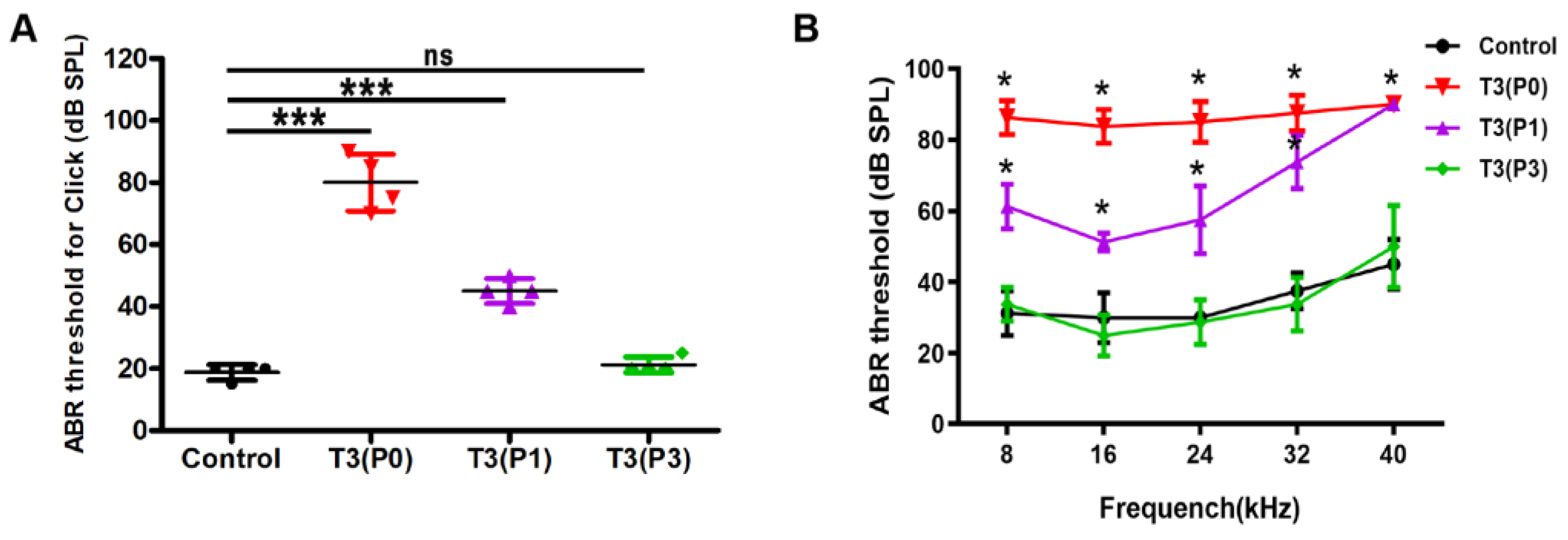
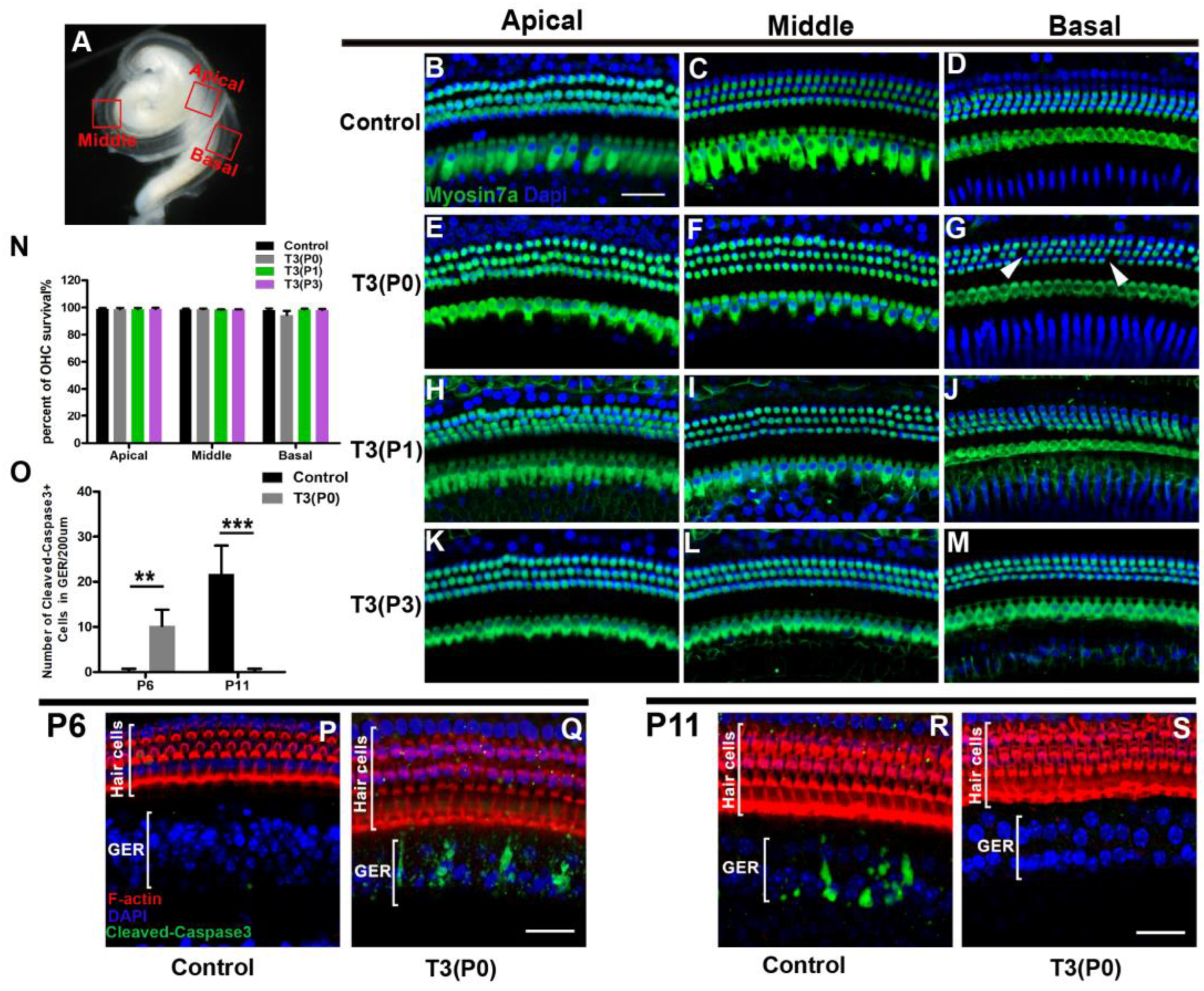
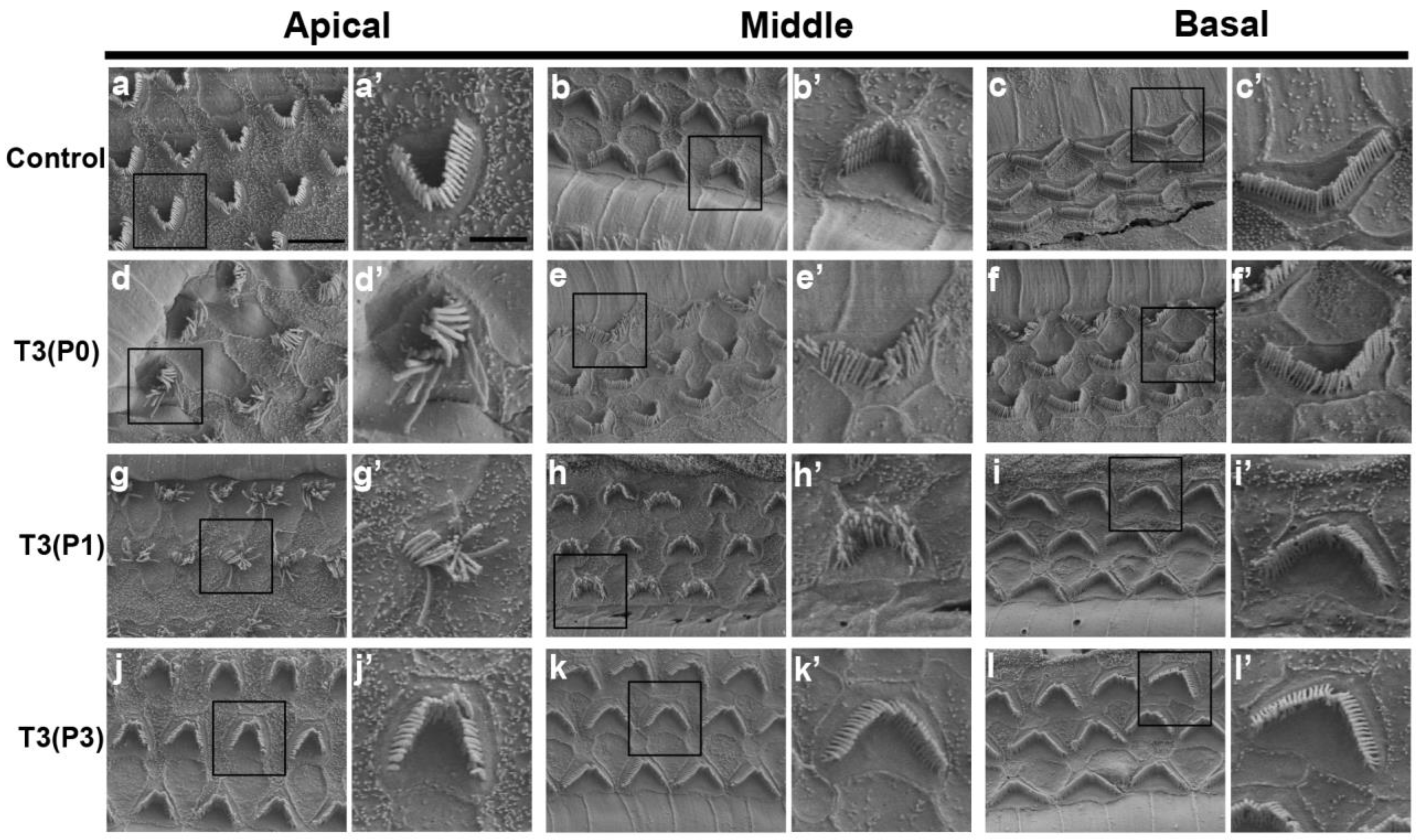
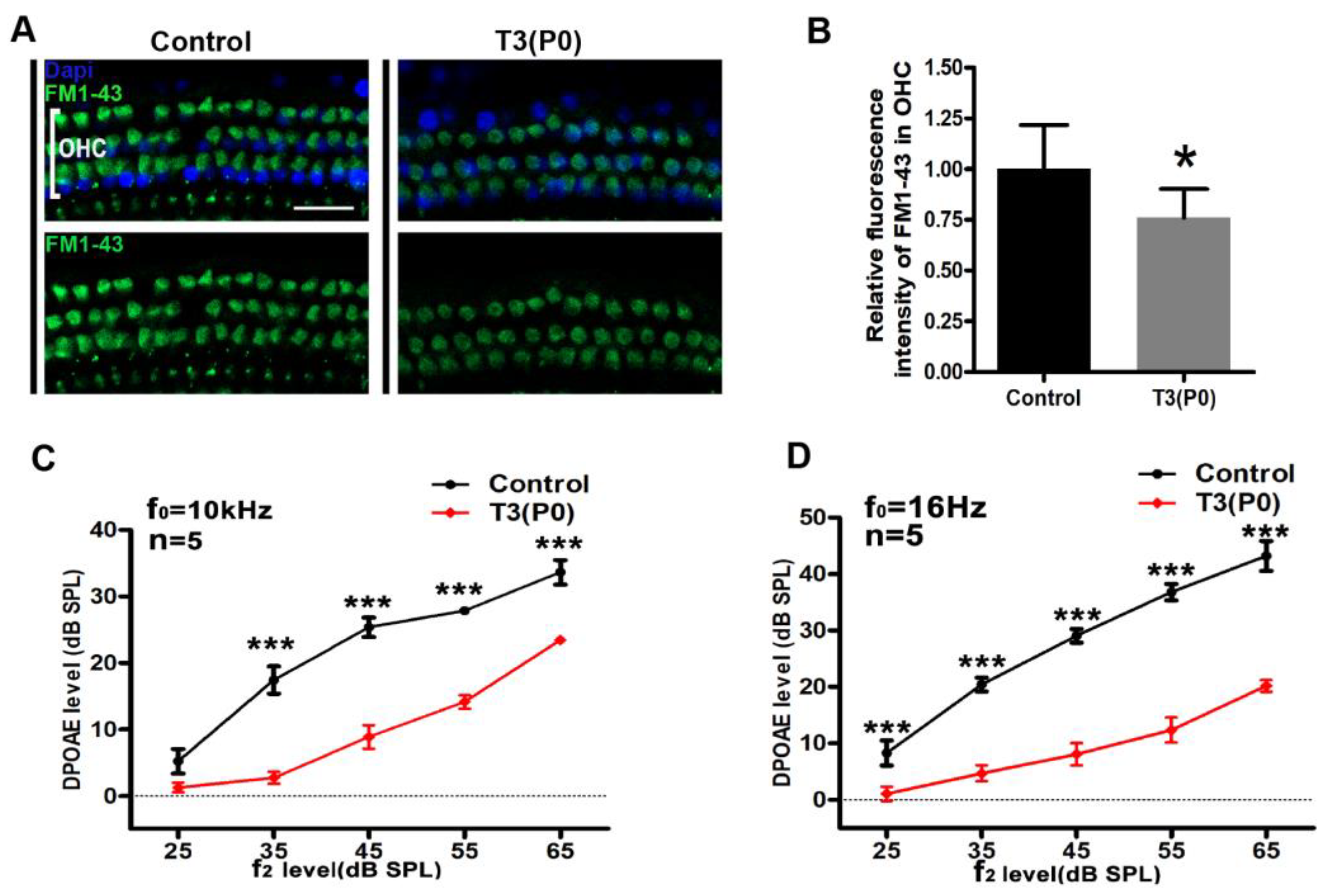
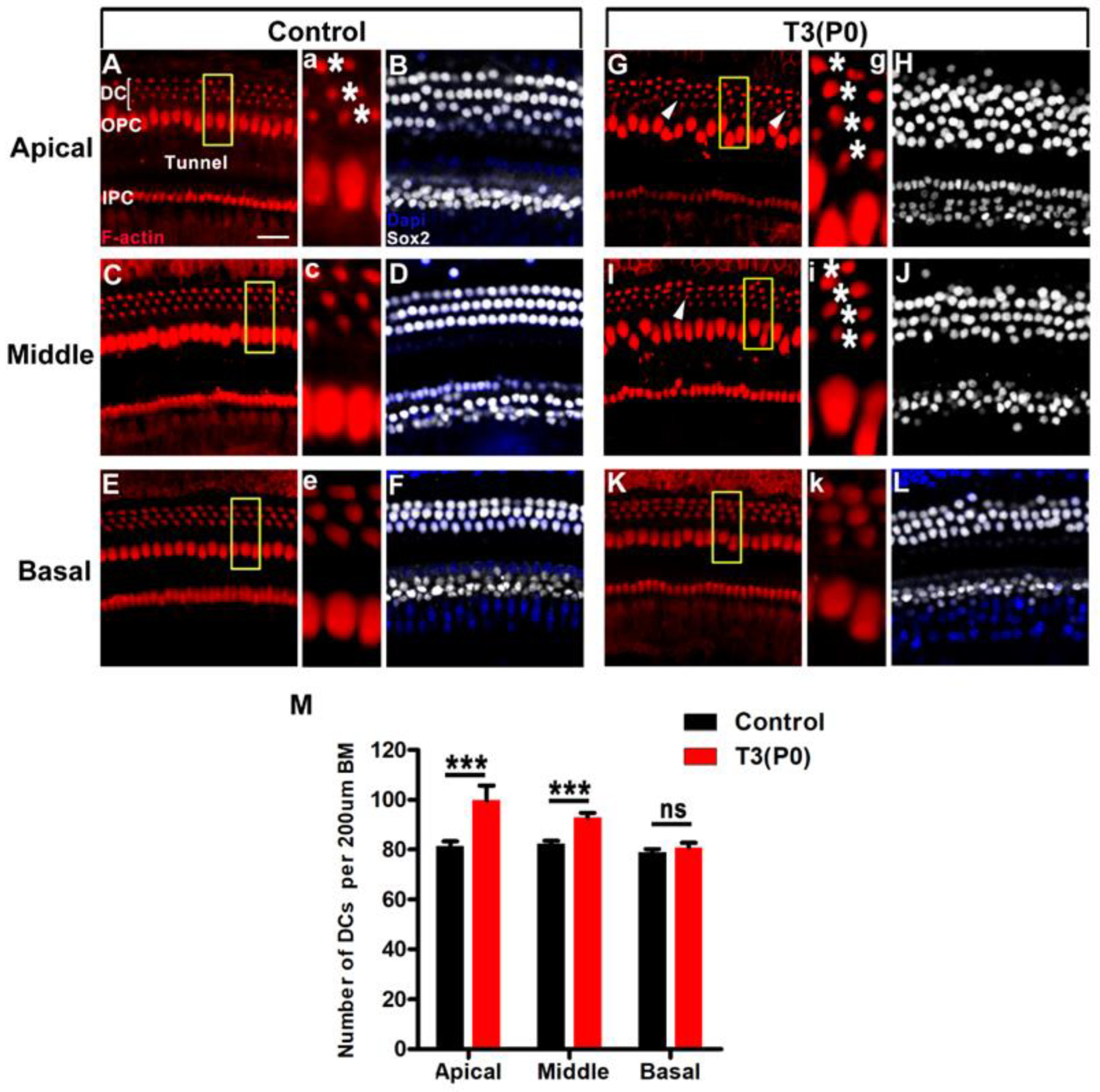
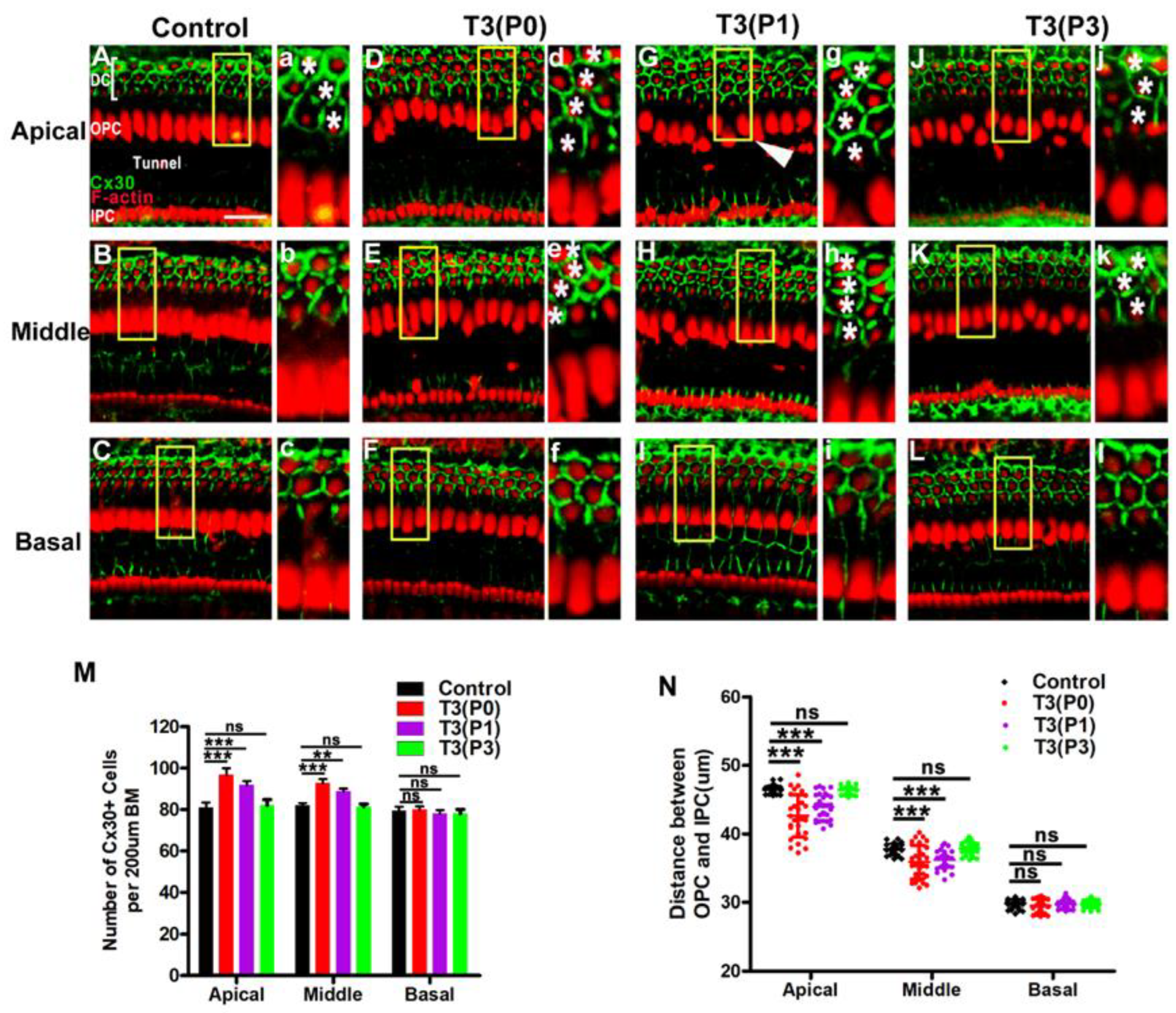

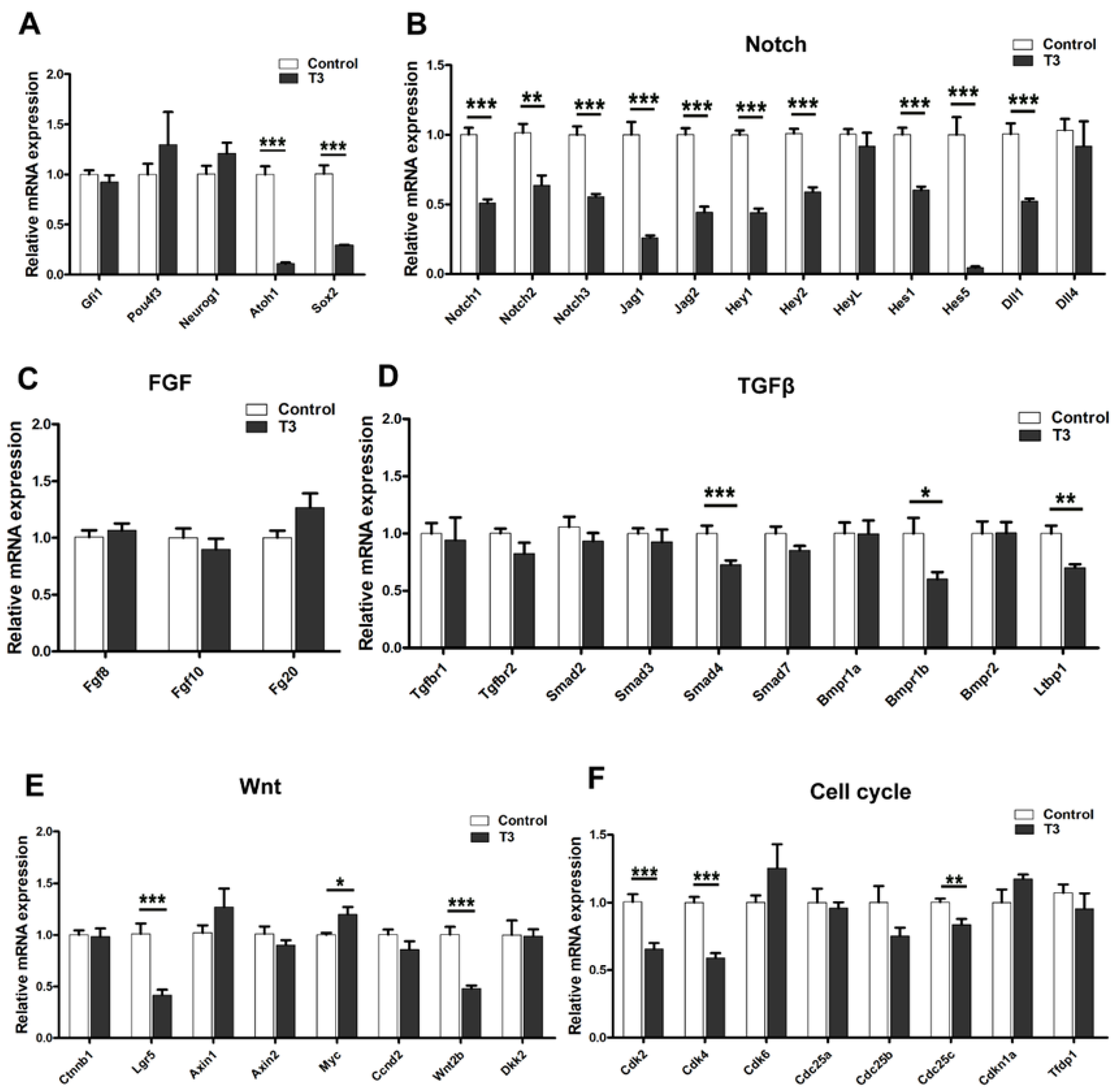
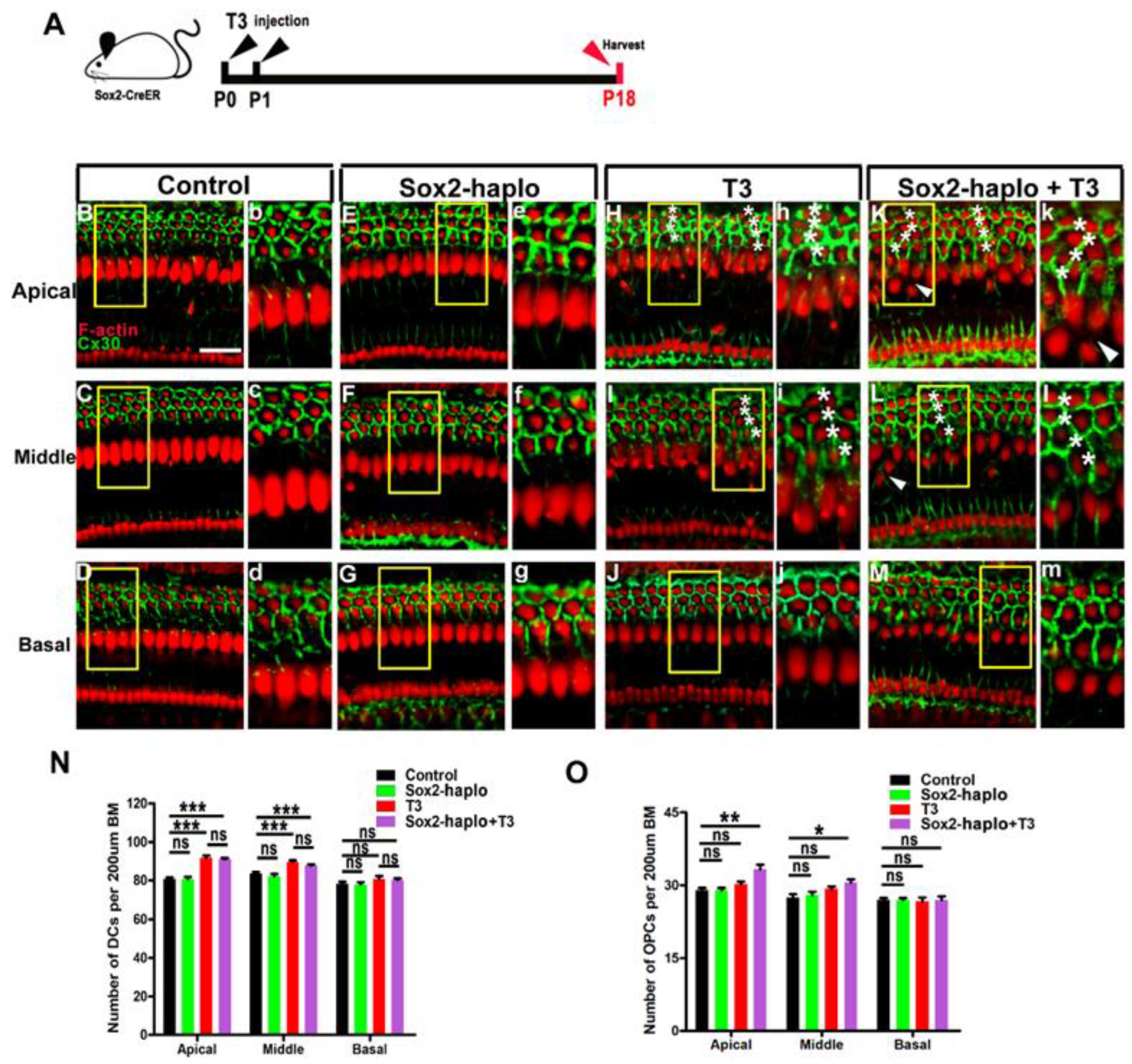
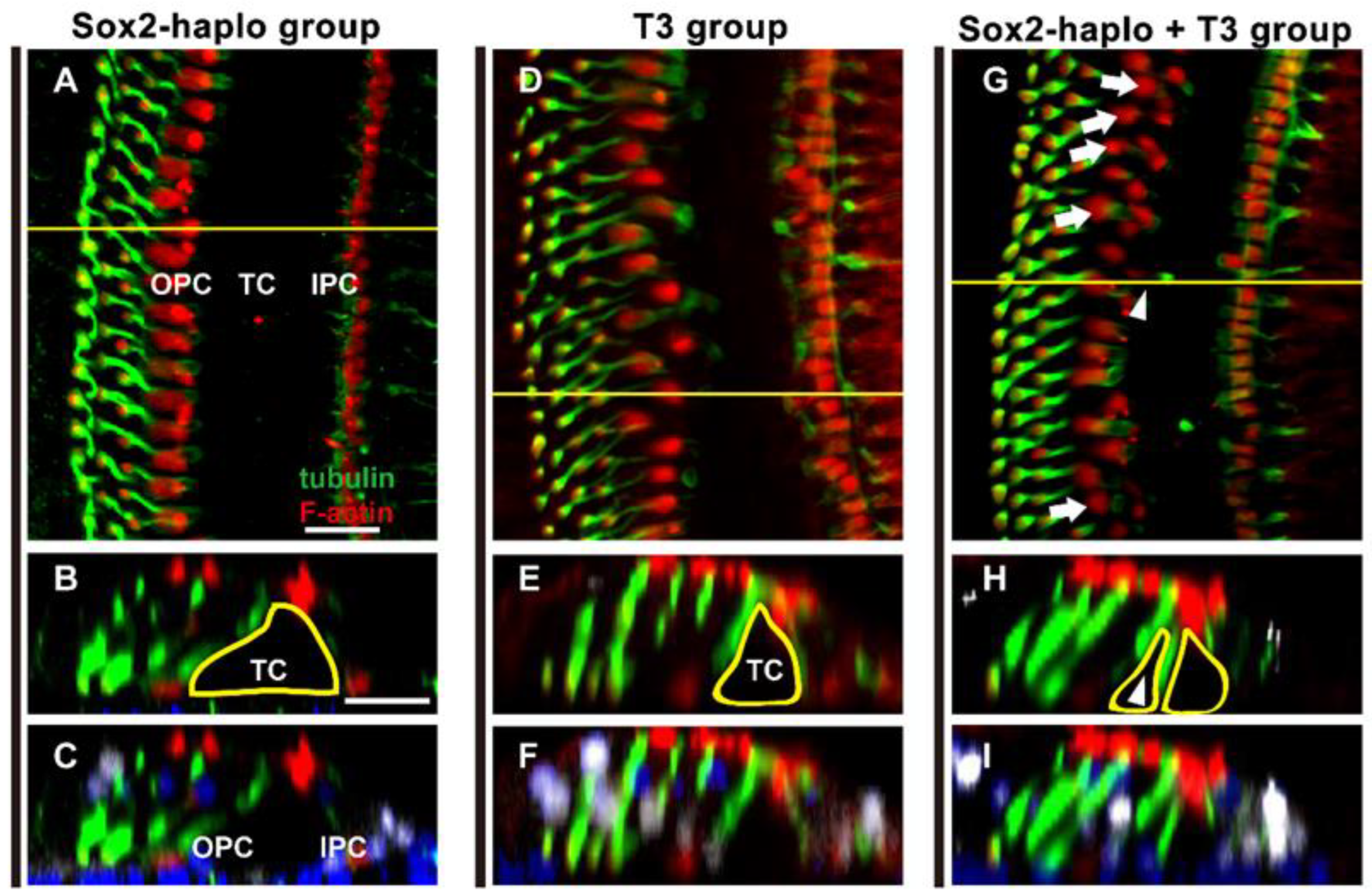
Disclaimer/Publisher’s Note: The statements, opinions and data contained in all publications are solely those of the individual author(s) and contributor(s) and not of MDPI and/or the editor(s). MDPI and/or the editor(s) disclaim responsibility for any injury to people or property resulting from any ideas, methods, instructions or products referred to in the content. |
© 2023 by the authors. Licensee MDPI, Basel, Switzerland. This article is an open access article distributed under the terms and conditions of the Creative Commons Attribution (CC BY) license (https://creativecommons.org/licenses/by/4.0/).
Share and Cite
Bai, X.; Xu, K.; Xie, L.; Qiu, Y.; Chen, S.; Sun, Y. The Dual Roles of Triiodothyronine in Regulating the Morphology of Hair Cells and Supporting Cells during Critical Periods of Mouse Cochlear Development. Int. J. Mol. Sci. 2023, 24, 4559. https://doi.org/10.3390/ijms24054559
Bai X, Xu K, Xie L, Qiu Y, Chen S, Sun Y. The Dual Roles of Triiodothyronine in Regulating the Morphology of Hair Cells and Supporting Cells during Critical Periods of Mouse Cochlear Development. International Journal of Molecular Sciences. 2023; 24(5):4559. https://doi.org/10.3390/ijms24054559
Chicago/Turabian StyleBai, Xue, Kai Xu, Le Xie, Yue Qiu, Sen Chen, and Yu Sun. 2023. "The Dual Roles of Triiodothyronine in Regulating the Morphology of Hair Cells and Supporting Cells during Critical Periods of Mouse Cochlear Development" International Journal of Molecular Sciences 24, no. 5: 4559. https://doi.org/10.3390/ijms24054559





